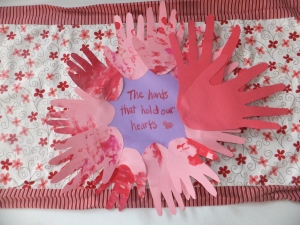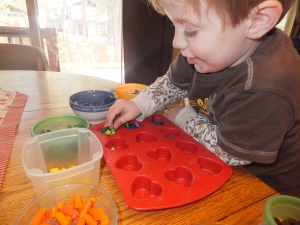Valentine’s Day has never been one of my favorite holidays for a variety of reasons, but this year I seem to be more in the spirit. I had fun planning out two weeks of activities for the boys. Yukon is very into holidays right now and has been asking to visit Santa for a few weeks. The concept of “you have to wait until next year” is way beyond him, so Valentine’s Day has been a fun distraction. We had a wonderful 2 weeks and I have planned for tonight a special candlelit dinner with all of us.
Here’s what we’ve done the last two weeks:
1. I love you to Pieces Activity.
2. Hands that hold our Hearts Activity
3. Made Crayon Hearts for Friends
4. 14 Reasons Why I Love You (for Olympus)
5. Made Pink Cookies
6. Watched the Bernstein Bears Valentine’s Day Episode (youtube)
7. Trip to the local library where they read V-day themed books
8. Read: You Are My I Love You by Maryann K Cusimano and Satomi Ichikawa
9. Candlelit Family Dinner
I Love you to Pieces Activity:
Skills and Knowledge: Art: Colors, gluing, cutting/ Social Studies: Holidays
What you need:
Construction paper in pinks, reds, purples, and/ or white
Scissors
Glue
Marker
 Pretty simple really and very similar to other activities we’ve done for other holidays. I cut strips of construction paper and had Yukon cut the strips into smaller pieces. You might need to help by holding the paper and letting your child concentrate on using the scissors at first. They get the hang of cutting fast though. Then I drew a heart on another piece of construction paper. Yukon then glued the pieces into the heart shape I drew. Yukon loves gluing- LOVES IT. He doesn’t like glue sticks though, which I find kind of strange. I then added the words “I love you to pieces” to the paper. We made this for White Knight.
Pretty simple really and very similar to other activities we’ve done for other holidays. I cut strips of construction paper and had Yukon cut the strips into smaller pieces. You might need to help by holding the paper and letting your child concentrate on using the scissors at first. They get the hang of cutting fast though. Then I drew a heart on another piece of construction paper. Yukon then glued the pieces into the heart shape I drew. Yukon loves gluing- LOVES IT. He doesn’t like glue sticks though, which I find kind of strange. I then added the words “I love you to pieces” to the paper. We made this for White Knight.
Original Idea from: http://www.pinterest.com/pin/220324606742669615/
Hands That Hold Our Hearts Activity:
Skills and Knowledge: Art: Colors, gluing/ Physical: Body Parts/ Social Studies: Holidays
What you need:
Construction paper in reds and pinks
Paint in reds and pinks
Scissors
Glue
Marker
I wanted to make a wreath of the boys’ hands for our door for Christmas but never got to it in December and decided to just go ahead and do it for Valentine’s Day. I had Yukon and North do some finger painting with Valentine’s Day colors. I was hoping that they would get some hand prints on the paper but it didn’t happen. North had a blast smearing paint everywhere and Yukon hated having the paint on his hands and wanted his hands washed every time I gave him a new paper. Finger painting with 2 kids is 4 times more work than with 1! After their painting dried we traced out their hands on plain construction paper and I traced those on the paintings and cut them out. Olympus made his own hands when he got home from school. Yukon and Olympus then glued the hands on another piece of construction paper cut into a circle and I added the words in the center.
Crayon Hearts:
Skills and Knowledge: Art: Colors/ Science: Cause and Effect/ Social Studies: Holidays, Giving
This was so much fun! I had seen it all over Pinterest and for some reason we had never done made them despite the growing number of broken crayons that Yukon refuses to color with. We made them as Valentine’s for Yukon’s friends and he talked about the colors they like as he filled the hearts. His best friend got quite a few made for him- they ended up coming out looking like camouflage! I love that we got to talk about a holiday, colors, and that crayons melt when hot! Social Studies, Art and Science.
What you need:
Crayons
Mold
Oven
Bowls to separate colors
Knife to cut up crayons
Step 1: Separate out the broken crayons and peel their wrappers off. I found it easier to group them by color as I did this because some of the colors, especially purple, are hard to figure out later without coloring on something.
Step 2: Cut the crayons into smaller pieces. I cut mine between ½ of an inch to ¾ of an inch. I put each color group into a separate bowl.
Step 3: Yukon filled a silicone heart mold with the different crayon pieces. Eventually, Olympus and even I couldn’t help but do a few. Martha Stewart used a metal mold so I’m sure those would be fine too, I just happen to have a silicone one.


Step 4: Bake the filled molds at a preheated oven at 170° F for about 40-60 minutes d epending on the size of the mold. When the crayons are melted pull out the mold and allow the crayons to cool. Pulling the mold out was a little tricky with the silicone mold as it wanted to tip over on me and if we do them again I would probably put the mold on a baking sheet.
epending on the size of the mold. When the crayons are melted pull out the mold and allow the crayons to cool. Pulling the mold out was a little tricky with the silicone mold as it wanted to tip over on me and if we do them again I would probably put the mold on a baking sheet.
Step 5: When cooled and hardened simple press them out the mold. If you’re using a metal mold I would imagine you would flip it over and tap and if they won’t come out stick them in the freezer for 30 minutes and try again.
We attached these to a few coloring pages out of a dinosaur coloring book for a simple and candy free Valentine for Yukon and North’s friends.
14 Reasons why I love you
Skills and knowledge: Social Studies: Holidays
Olympus loved these hearts. I wish I would have thought of it years ago as an inspiration for reading. Regardless, he thought they were pretty special and didn’t even bother to be 14 and pretend he didn’t care like I half expected him to. I think they will have to become a tradition.
What you need:
Construction paper- I used pink
Scissors
Tape
Marker
 Step 1: Cut 14 hearts out of the construction paper. I find it easiest to fold the paper to the desired half width and then cut half a heart into the folded edge. This makes a symmetrical heart- otherwise the lack of symmetry drives me nuts.
Step 1: Cut 14 hearts out of the construction paper. I find it easiest to fold the paper to the desired half width and then cut half a heart into the folded edge. This makes a symmetrical heart- otherwise the lack of symmetry drives me nuts.
Step 2: Label the hearts 1 through 14 on one side.
Step 3: Write “I love you because ________________” and fill in the blank with something different for each heart on the blank sides of the heart.
Step 4: Starting with the 1st of February tape a heart number side out to their door every day until Valentine’s Day. I ended with “I love you because you are YOU!”
The original idea for this came from http://kiddosathome.com/2013/01/07/starting-feb-1st-let-them-wake-up-to-a-new-heart-on-their-door-to-something-i-love-about-them/
Cookie Making
Skills and Knowledge: Social Studies: Holidays, Sharing / Science: Measuring/ Art: C olors, Shapes, Shaping Dough
olors, Shapes, Shaping Dough
For making cookies Yukon and I made some very good White Chocolate Cherry Shortbread Cookies from Mel’s Kitchen Café. He helped me with the measuring and making the cookies into ball shapes. They turned out very pretty. North has helped dump things into the mixer to make cookies before but I find that my patience is exhausted for a week after having a 1 year old AND a 3 year old helper at the same time so now we trade off who gets to help.
Cookie Recipe Here: http://www.melskitchencafe.com/2012/12/white-chocolate-cherry-shortbread-cookies-sugar-rush-6.html
We also had a play date with a friend of the boys’ from the neighborhood who invited us over to decorate heart and lip shaped cookies. North actually had the most fun with this and went through twice as many cookies as the other boys despite being so much younger. All three boys shared the sprinkles very well and I learned that using Ziploc bags for the icing makes life so much cleaner. Our friend filled a bag for each boy and cut a small hole in one corner. I realize this is not a revolutionary idea but for some reason I had never realized how much easier this squeeze bag would be for little boys than cups with butter knives. I guess we all can learn things from play dates.
HAPPY VALENTINE’S DAY!
 We had so much fun doing this and seeing the animals cemented what they were in Yukon’s mind. Prior to this he would get confused between a zebra and a horse and a giraffe was not worth looking at, but now he talks about them all the time. Experiences like this are the best kind of learning experience. Not everyone has this kind of park available to him but there are lots of similar options available in most places. When Olympus was little we lived on the coast and he loved to go to an aquarium in a nearby city that had the tanks that you could reach in and touch everything in- he knew all the types of animals in there before he was three.
We had so much fun doing this and seeing the animals cemented what they were in Yukon’s mind. Prior to this he would get confused between a zebra and a horse and a giraffe was not worth looking at, but now he talks about them all the time. Experiences like this are the best kind of learning experience. Not everyone has this kind of park available to him but there are lots of similar options available in most places. When Olympus was little we lived on the coast and he loved to go to an aquarium in a nearby city that had the tanks that you could reach in and touch everything in- he knew all the types of animals in there before he was three.












